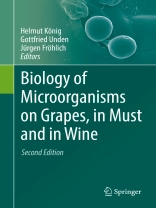The second edition of the book begins with the description of the diversity of wine-related microorganisms, followed by an outline of their primary and energy metabolism. Subsequently, important aspects of the secondary metabolism are dealt with, since these activities have an impact on wine quality and off-flavour formation. Then chapters about stimulating and inhibitory growth factors follow. This knowledge is helpful for the growth management of different microbial species. The next chapters focus on the application of the consolidated findings of molecular biology and regulation the functioning of regulatory cellular networks, leading to a better understanding of the phenotypic behaviour of the microbes in general and especially of the starter cultures as well as of stimulatory and inhibitory cell-cell interactions during wine making. In the last part of the book, a compilation of modern methods complete the understanding of microbial processes during the conversion of must towine.
This broad range of topics about the biology of the microbes involved in the vinification process could be provided in one book only because of the input of many experts from different wine-growing countries.
विषयसूची
Diversity of Microorganisms.- Lactic Acid Bacteria.- Acetic Acid Bacteria.- Yeasts.- Fungi of Grapes.- Viruses of Wine-Associated Yeast and Bacteria.- Yeast Mixtures and Saccharomyces Hybrids: Suitable Tools for Performing More Sophisticated Must Fermentations.-Phytopathogenic Microorganisms on Vine.- Primary, Secondary and Energy Metabolism.- Sugar Metabolism by Saccharomyces and non-Saccharomyces Yeasts.- Metabolism and Tansport of Sugars and Organic Acids by Lactic Acid Bacteria from Wine and Must.- Amino Acid Metabolisms and Production of Biogenic Amines and Ethyl Carbamate.- Usage and Formation of Sulphur Compounds.- Polysaccharide Production by Grapes, Must, and Wine Microorganisms.- Microbial Enzymes: Relevance for Winemaking.- Laccases of Botrytis cinerea.- Polyphenol Oxidases from Wine Grapes.- Stimulating and Inhibitory Growth Factors.- Physical and Chemical Stress Factors in Yeast.- Physical and Chemical Stress Factors in Lactic Acid Bacteria.- Influence of Phenolic Compounds and Tannins on Wine-Related Microorganisms.- Molecular Biology and Regulation.- Genomic evolution and adaptation to wine of Oenococcus oeni.- The Genome of Acetic Acid Bacteria.- Plasmids from Wine-Related Lactic Acid Bacteria.- Modern Methods.- Molecular Methods for Identification of Wine Microorganisms and Yeast Development.- Maintenance of Wine-Associated Microorganisms.- DNA Arrays.- Application of Yeast and Bacteria as Starter Cultures.- Application of Microbial Enzymes during Wine Making.- Mass Spectrometry, a powerful tool for the identification of wine-related bacteria and yeast.
लेखक के बारे में
Prof. Dr. Helmut König,
Johannes Gutenberg University,
Inst. Microbiology and Wine Research,
Mainz,
Germany
Dr. Jürgen Fröhlich,
Erbslöh Geisenheim AG,
Geisenheim,
Germany
Prof. Dr. Gottfried Unden,
Johannes Gutenberg University,
Inst. Microbiology and Wine Research,
Mainz,
Germany












